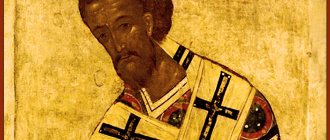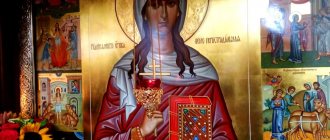It is impossible to imagine Christian worship without church singing, which lifts the soul to the heavenly heights, penetrates deeply into the heart and directs all thoughts to the Divine Word. Over hundreds of years, a certain canon has developed for each church service, including its musical accompaniment. Some chants have come to us from time immemorial, created by unknown authors, but the name of one of them is well known to every believer - this is St. Roman the Sweet Singer, whose icon is in many churches and is a must for those who devote themselves to church singing. The nickname alone testifies to how highly he was appreciated by his contemporaries, and the very story of his acquisition of talent is a real miracle.
Memory of St. Roman the Sweet Singer is celebrated on October 14, the Feast of the Intercession of the Blessed Virgin Mary.
Life story
The future saint was born in Syria at the end of the 5th century, was baptized in his youth and, dreaming of devoting his life to serving the Lord, became a deacon in the temple in Beirut and finally went to Constantinople and became one of the clergy in the Church of Our Lady. Roman did not stand out in any way among the rest of the clergy, but Patriarch Euthymius fell in love with the young man for his commitment to the faith and virtuous life, began to single him out and brought him closer to himself.
This caused envy among some clergy; they mocked the young man because of his lack of education, as well as the complete lack of voice and hearing. Uncomplainingly enduring these insults, Roman showed truly Christian forgiveness, but one incident completely turned his life upside down.
Once a large festive service was going on in the temple, and the envious clergy decided to expose the timid young man to public ridicule. They pushed him into the pulpit and he had to sing in front of the assembled congregation. Roman's trembling voice and his indistinct singing, if they did not cause laughter, then made an unfavorable impression, but he himself was in despair.
Returning home, Roman began to pray passionately in front of the icon of the Mother of God. And then a real miracle followed: the Mother of God came down to him from heaven, handed him a scroll and ordered him to swallow it. Roman did just that. It turned out that he received from the Mother of God not only a beautiful voice and hearing, but also an even more valuable gift - to compose church hymns, which required talent not only for versification, but also for music. Immediately, under the impression of the appearance of the Mother of God, the novel compiled the Christmas kontakion “The Virgin Gives Birth to the Most Essential One,” which became famous and is still performed in Orthodox churches on the great festive night.
The next day he brought his first piece to the temple and sang it himself in a beautiful, sonorous voice. Everyone was shocked by his magnificent voice and the beauty of the chant he wrote, and the former envious people and oppressors repented of their bad attitude towards him, and the kind-hearted young man forgave them.
In total, Roman owns more than a thousand church hymns, including troparia, kontakion and akathists, which became a real decoration of any divine service and made, and still make, a huge impression on believers. That is why Roman received the nickname Sweet Singer.
Surrounded by universal love, Roman began to teach singing in Constantinople and did a lot to make the divine services acquire even greater splendor. Both contemporaries and scientists who studied his creative legacy believed that among all other Greek creators of church hymns he stood out for his sublime poetic talent, depth, sincerity of feelings and musical talent.
Roman the Sweet Singer died in 556, having previously taken monastic vows, and was subsequently canonized by the Church Council. Now an akathist was created for Saint Roman the Sweet Singer and the history of his life was written.
How do prayers to Saint Roman the Sweet Singer help?
The venerable saint wrote many ecclesiastical works:
- church hymns;
- strong prayers;
- kontakion and akathists.
Today, each of us can offer a prayer to the Venerable Roman the Sweet Singer in order to better understand the Holy Scriptures.
In the Kiev Church there is a piece of the relics of the Venerable One, and it is there that many believers come to offer a prayer to Roman the Sweet Singer for the acquisition of wisdom and knowledge.
O great and wonderful Roman, truly a sweet singer. We appeal to you, partaker of heavenly glory and adornment of angelic faces - cleanse our hearts, so that we worthily serve our one and only Lord. You know the difficulties of the earthly path and already know the jubilant holy joy of heaven. You know that many of us long to serve with all our soul, strength and thought, but our passion-stricken souls drag us to the bottom of a dark abyss.
Don't leave us in the dark. Knowing what we may lose, help us worthily glorify the Lord, His Most Pure Mother and all the saints. Help us to cleanse ourselves of passions, guide our lips, pray to the sweetest Lord, that He will give us the right understanding of the singing ministry. May we worthily stand on the one holy heavenly choir and give glory to our Lord forever and ever.
Prayers to the saint help develop talents and abilities; the saint also protects men named Roman. They ask the Reverend for protection from enemies and envious people, as well as in difficult moments of life.
Description of the icon of Roman the Sweet Singer
As a rule, the icon of Roman the Sweet Singer depicts a handsome young man, sometimes in the vestments of a deacon - in a surplice and with an orarion (a ribbon thrown over his shoulder). His right hand is raised and makes the sign of the cross, and in his left he holds an unrolled scroll with the text of his most famous kontakion.
The Mother of God is also present in the icon with the same scroll in her hands, thanks to which Roman received his marvelous voice and talent for writing.
Prayers
Troparion, Greek, tone 4
[1]
Like a god-pleasing trumpet of heavenly chants, / you have divinely illuminated the Church of Christ / with your divine songs. / For you have received inspiration from the illumination of the Mother of God, / you have appeared in the singing sky in the world./ For this reason we honor you with love, // Reverend Roman.
Kontakion, tone 8
With the divine virtues of the spirit/ adorned from childhood, Roman the wise,/ you were a most honorable adornment of the Church of Christ:/ having adorned you with beautiful singing, blessed one./ Thus we pray to you: grant what you desire. to those of your Divine gift, / as we cry to you: Rejoice, blessed father , church beauty.
What do they pray to the icon of Roman the Sweet Singer for and what does it protect against?
Roman the Sweet Singer, to put it in modern language, was a composer who wrote church works, therefore the icon “St. Roman the Sweet Singer” enjoys special veneration among all who devoted their lives to music and especially church singing. And an icon with a prayer to the miracle worker Roman will help you gain confidence in yourself and your abilities, overcome the machinations of envious people, as happened with Roman himself, and creative people will develop their poetic, musical and performing talent. You can turn to her in other difficult circumstances.
Where is the image of St. Roman located?
The Venerable Roman the Sweet Singer made a tremendous contribution to church hymns, giving it a special melody and harmony. For his labors and loyalty to the Lord, he was canonized as a saint, and an icon was painted in his honor. Currently, his songs and prayers are read in every church.
The holy image of St. Roman the Sweet Singer adorns many churches in our homeland. Particular veneration is paid to the icon of the Righteous One in the Church of the Nativity of the Virgin Mary in St. Petersburg. Every year on October 14, a service is held in the church in memory of St. Roman.
Also, two churches were erected in honor of the martyr: the Church of Roman the Sweet Singer in St. Petersburg and in Moscow, on the territory of the Transfiguration Cathedral at the Novo-Spassky Monastery.
Creative heritage
Roman the Sweet Singer left the greatest memory of himself as the author of many chants: kontakia, ikos, hymns, prayers and akathists. Roman was the author of both the words and the music of these works, which were included in the treasury of Orthodox hymnography. The hymns of Roman the Sweet Singer usually contain variations on the themes of biblical stories.
Appearance of the Mother of God to Roman the Sweet Singer. OK. 985
Roman Sladkopevets is considered the author of more than a thousand works. Despite the fact that over time, kontakia were replaced in Orthodox hymnography by another type of chants - canons, the influence of the work of Roman the Sweet Singer on later authors remained very significant over the centuries.
The canons developed themes that were started by Roman the Sweet Singer; the kontakion “Today the Virgin is giving birth to the Most Essential”, which he composed, is still performed in Christmas services; the initial stanzas of many canons, which we call today kontakia, have been preserved from the time of Roman.
Among the most significant works of Roman the Sweet Singer are the already mentioned kontakion to the Most Holy Theotokos, as well as kontakia to St. Nicholas the Wonderworker, the holy unmercenary Cosmas and Demian, Simeon the Stylite and others.
Regent's Prayer for Fiery Service
O most good Lord, holy Creator of heaven and earth. Grant me, unworthy, to become Your true servant and manifest Your holy will on me. May I lead my brothers and sisters who sing to You in truth and righteousness to Your worthy praise. May my service glorify Your holy service and may our singing work strengthen and give Your chosen people a thirst for prayer to You.
O most kind Lord, grant to my brothers and sisters in the singing ministry a tender heart that is pleasing to You. Soften their hearts, grant them understanding of my regency labors, so that they will not fall into temptation and be offended by me, a sinner. Give me angelic wisdom, a fiery and laborious heart, inexhaustible strength and a holy thirst for serving You, so that we may be strengthened for singing feats in Your Holy Name. To you be glory, honor and worship forever and ever, amen.
Compilation of the life of a saint
Before we find out how Roman Sladkopevets helps, let’s study in detail the information available in the Christian church archives.
For example, in the Patmos Codex there is information that he was from Syria and the city of Emessa and was born into a Jewish, but already Christianized family. After some time, he began to serve as a deacon in the Holy Church of God (of the Resurrection) in Beirut. And then Constantinople, where Tsar Anastasius ruled at that time, awaited him. In Kira, he began to serve in the Church of the Mother of God, where he received grace from the Mother of God Herself. She appeared to him in a subtle dream and gave him a parchment scroll, which she ordered him to eat.
When the saint devoured him, he immediately woke up and, ascending to the pulpit, began to proclaim the euphonious chant: “Today the virgin gives birth to the Most Essential.” After Roman the Sweet Singer, whose icon is often depicted with a huge letter, compiled the Lord's holidays and the days of remembrance of the Saints, the number of which turned out to be about a thousand. Written by his hand, they are still kept in Kira.
Constantinople
Having moved to Constantinople, he settled in Kira near the Church of Our Lady (Kyriotissa). It was there that the vision spoken of in the synaxari took place. Proof of this could be the constant stay of Saint Roman in Cyra (in this modest quarter his body was buried near the church), although he could claim more.
And all because Kyriotissa became a holy place for him. Another proof of the vision is the appearance of the kontakion at Christmas. This means that the gift of poetic talent, with the blessing of the Mother of God, was accomplished.
In addition to a short version of this event, there is also a much later widespread version (XIII-XIV centuries). The Monk Acadius Savvait tells that Saint Romanus had no voice and could not read at all, for which his brothers were often ridiculed. He prayed to the Mother of God, and then She appeared to him in a dream and asked him to make him sad and gave him a scroll, in return he promised to become a monk. Roman absorbs the scroll and soon takes monastic vows at the Awassu monastery. However, the recognition that Romanus became a monk from Akaki’s narrative became erroneous, and the monastery of Awassu itself is almost unknown in early sources.
Knowledge in law
His creations were also influenced by his stay at the center of jurisprudence. In his creations, he often carries a legal thought, where his good lawyer and investigative skills are felt.
It is not known why Saint Romanus left Beirut and went to Constantinople, but there are some assumptions that he moved there in 512, when the Orthodox Patriarch Flavian of Antioch was deposed, and the theologian and monophysite Severus of Antioch came to his place.
During his reign, serious oppression of Orthodox ministers began. Beirut was a prominent center along with the Church of the Resurrection. And Saint Romanos, who sculpted kontakia and always professed Orthodoxy and pro-Chalcedonian views, certainly could have immediately attracted attention and become an expelled victim of the Monophysite church rulers. Or perhaps he himself left, unable to bear the oppression. An indirect confirmation of this is the kontakion of the Three Youths.
New evidence
The menology of Vasily II adds some more to this information. That, being in a reverent state and incessant prayers at the vigil in the Church of the Virgin Mary in the Constantinople estate of Blachernae, Saint Roman the Sweet Singer repeatedly returned to Syrian Cyrus. Another early source - the life of Saint Artemius - has an episode from the reign of Heraclius, which describes that from a young age Saint Artemius prayed and chanted “verses like those of the humble Romanos.”
This is what Saint Roman the Sweet Singer looks like at first glance. How does his holy image help? This question interests many Orthodox Christians. Church singers pray to this saint for help in the art of singing.
The service to Saint Romanus - another group of testimonies - the canon, was published in the Menaion and signed with the name of Epiphanius in the Theotokos. It also contains some information about the life of Saint Romanos, in particular, it states: “from his youth, Saint Romanos dedicated himself entirely to Christ” (canto 1:2), and lived as an ascetic in Constantinople. This canon also describes the miracle of the appearance of the Mother of God to him (canto 5, troparion 2).
Some more information about the saint is given by the canon of Theophan Grapt, which says that he was the best deacon (6 canto, 1 troparion), who served as a preacher through his hymns. In this canon (canto 4.2). It is also said that he studied the Scriptures from early childhood, and when he arrived in Constantinople, he constantly attended the Church of the Virgin Mary at Blachernae.
But the most interesting fragment of the kontakion for St. Roman was published by Cardinal Pitra and Grodidier de Maton. Only three ikos have reached our contemporaries, where the life of Saint Roman is praised, and especially in the second and third ikos.
Holiness
From the life of Saint Artemius one can learn that Roman the Sweet Singer was revered as a saint already from the time of Heraclius, since the hymns he composed were sung at vigils. And his grave was preserved for centuries, even in the 13th century it was shown to Anthony of Novgorod, who later wrote down that the holy hymnographer was buried in the Church of the Annunciation of the Blessed Virgin Mary.
Roman Sladkopevets, whose temple can be visited in Kyiv and Nizhnekamsk, began teaching singing in Constantinople. Thanks to his hard work, love for God and, of course, talent, the splendor of Orthodox services was highly elevated. Thanks to his poetic gift, he occupied a special niche among church hymn writers.
The saint composed more than a thousand prayers and hymns for various church holidays. His akathist to the Annunciation of the Virgin Mary, which is sung on the fifth Saturday of Great Lent, is especially famous. His creations became models, according to which other akathists were later compiled. This saint raised the splendor of Orthodox service very highly and therefore occupies an honorable place among church hymnals. The date of his death is October 14 (October 1, Old Style), somewhere between 555 and 562.
Medical practice of the saint
Roman Sladkopevets lived a long life. His Jewish origin suggests that, in addition to moneylending in the Byzantine world, Jews often practiced medicine, and most likely his family belonged to this environment. He clashed with the medical corporation of Emessa, reduced the price for medical services and often treated for free.
Therefore, there are suggestions that the move of Saint Romanus from Emessa to developing Beirut, which in the 6th century was a major cultural center of the eastern Mediterranean, where there were always many temptations and boastfully displayed wealth, was connected with these questions. It was very difficult for a provincial Jew to make his way in such a large and sophisticated city. To do this, one had to have extraordinary abilities. And Saint Roman, despite all the difficulties, still succeeded.
Most likely, the attention of church authorities was attracted by his poetic talent. And then he was ordained as a deacon to serve in the Beirut Church of the Resurrection, which was very majestic. His position here as a deacon was associated with charitable duties.







